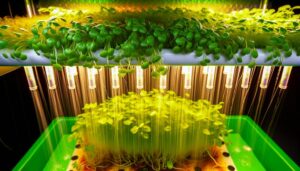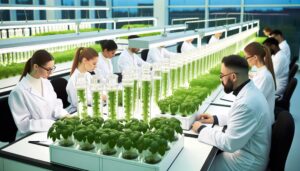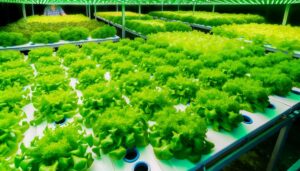Safely Using Hydroponic Nutrients to Prevent Potential Risks to Plant Food
Hydroponic nutrients can harm plant food if improperly managed.
Balanced nutrient solutions with appropriate macronutrient and micronutrient concentrations are essential for healthy plant growth. Mismanagement can result in nutrient imbalances, leading to deficiencies or toxicities.
Chemical residues from synthetic nutrients might accumulate, affecting both plant metabolism and the safety of edible crops. Ensuring correct pH and electrical conductivity levels is critical to prevent root damage and osmotic stress.
Additionally, nutrient leaching poses environmental risks, such as eutrophication. Understanding best practices and precise nutrient application can mitigate these risks considerably, ensuring healthier plant food and environmental safety.

Key Takeaways
Understanding Hydroponic Nutrients
Hydroponic nutrients are specifically formulated solutions that supply essential minerals and elements to plants grown in soilless systems. These nutrients are critical for plant growth and development, compensating for the absence of soil.
Standard hydroponic solutions contain macronutrients such as nitrogen, phosphorus, and potassium, along with essential micronutrients like iron, magnesium, and zinc. The precision in nutrient formulation is paramount, as it directly influences plant health and yield.
Research indicates that hydroponic systems can achieve faster growth rates and higher yields compared to traditional soil cultivation. However, the efficacy of these nutrients relies heavily on their correct application, monitoring, and adjustment.
Mismanagement can lead to nutrient imbalances, potentially causing adverse effects on plant health and food quality.
Composition of Nutrient Solutions
To guarantee ideal plant growth in hydroponic systems, nutrient solutions must be carefully formulated with a balanced mix of essential macronutrients and micronutrients.
Macronutrients such as nitrogen (N), phosphorus (P), and potassium (K) are required in larger quantities and play crucial roles in plant development, including photosynthesis and cellular structure.
Secondary macronutrients like calcium (Ca), magnesium (Mg), and sulfur (S) are also essential for various physiological processes.
Micronutrients, including iron (Fe), manganese (Mn), zinc (Zn), copper (Cu), molybdenum (Mo), and boron (B), are needed in trace amounts but are indispensable for enzyme function and growth regulation.
Precise concentration and ratio adjustments of these nutrients are paramount to avoid deficiencies or toxicities, ensuring excellent plant health and yield.
Synthetic Vs. Organic Nutrients
The comparison between synthetic and organic nutrients hinges on their distinct sources. Synthetic nutrients are chemically manufactured, while organic nutrients are derived from natural materials.
Studies indicate that synthetic nutrients can lead to environmental concerns such as nutrient runoff and soil degradation. In contrast, organic nutrients are generally considered more environmentally sustainable.
This section will examine the implications of these differences on plant health and ecosystem integrity.
Nutrient Source Differences
A critical examination of nutrient source differences reveals distinct impacts on plant health and growth efficiency between synthetic and organic nutrients.
Synthetic nutrients, often derived from inorganic compounds, provide precise control over nutrient composition, ensuring peak growth rates and yield consistency. However, they can lead to nutrient imbalances and potential toxicity if not meticulously managed.
Conversely, organic nutrients, sourced from natural materials such as compost or manure, promote beneficial microbial activity and soil health, contributing to sustainable growth. Yet, they may present challenges in nutrient availability and consistency.
Research indicates that while synthetic nutrients can offer immediate benefits, organic alternatives foster long-term soil vitality and ecosystem balance, highlighting the importance of selecting appropriate nutrient sources based on specific horticultural objectives.
Environmental Impact Comparison
Evaluating the environmental impact of synthetic versus organic nutrients reveals significant differences in their effects on soil health, water quality, and ecosystem sustainability.
Synthetic nutrients often lead to nutrient runoff, contributing to water pollution and eutrophication. Conversely, organic nutrients enhance soil structure and microbial activity, promoting long-term soil fertility.
| Aspect | Synthetic Nutrients | Organic Nutrients |
|---|---|---|
| Soil Health | May degrade over time | Enhances soil structure |
| Water Quality | Potential for runoff and pollution | Lower risk of water contamination |
| Ecosystem Impact | Can harm aquatic ecosystems | Supports biodiversity |
| Resource Use | Generally less resource-intensive | Often requires more resources to produce |
Understanding these differences is crucial for sustainable agricultural practices.
Concentration Levels
Understanding the ideal concentration levels of hydroponic nutrients is essential for preventing potential phytotoxicity and ensuring healthy plant growth. Ideal nutrient concentration varies between species and is influenced by growth stages.
Research indicates that excessive nutrient levels can lead to ion toxicity, nutrient imbalances, and osmotic stress, impairing plant development.
Conversely, insufficient concentrations may result in nutrient deficiencies, stunted growth, and lower yield. Monitoring electrical conductivity (EC) and pH is critical, as these parameters reflect nutrient availability and uptake efficiency.
Studies recommend maintaining EC levels between 1.2 to 2.5 mS/cm for most crops, with pH values ranging from 5.5 to 6.5.
Accurate dosing, regular monitoring, and adjustments are pivotal to achieving ideal nutrient balance and plant health in hydroponic systems.
Potential Chemical Residues
In addition, potential chemical residues from hydroponic nutrient solutions can accumulate in plant tissues, leading to unintended consequences.
Studies indicate that these residues may alter the organoleptic properties of the produce, impacting flavor and consumer acceptance.
Moreover, the long-term health implications of consuming such chemically-laden produce remain an area of concern that warrants further investigation.
Chemical Residue Buildup
The accumulation of chemical residues in hydroponic systems can lead to significant adverse effects on plant health and food safety, necessitating rigorous monitoring and management practices.
Elevated levels of residual nutrients, such as nitrates and phosphates, can disrupt plant metabolism, potentially leading to phytotoxicity and nutrient imbalances.
Studies have shown that persistent chemical residues can also foster the proliferation of harmful microorganisms, further compromising plant vitality.
Failure to adequately manage these residues may result in bioaccumulation, posing risks to human health upon consumption.
Implementing precise nutrient dosing schedules, regular water quality assessments, and effective waste management protocols are critical in mitigating these issues.
Consequently, understanding and managing chemical residue buildup is essential for sustainable hydroponic farming.
Residue Impact on Flavor
Elevated concentrations of chemical residues in hydroponic systems can adversely affect the flavor profile of cultivated plants, leading to undesirable taste characteristics.
Studies indicate that specific nutrient imbalances, particularly elevated levels of nitrates and heavy metals, can impart a metallic or bitter taste to produce.
Additionally, excessive sodium uptake can result in a saline flavor, especially in sensitive crops like leafy greens. Analytical chemistry assessments reveal that residue accumulation is contingent on nutrient solution composition and plant absorption efficiency.
Hence, meticulous management of nutrient solutions is imperative to minimize potential flavor degradation. Ensuring balanced, ideal nutrient concentrations can mitigate residue impact, thereby preserving the sensory quality of hydroponically grown produce.
Nutrient Imbalances
Nutrient imbalances in hydroponic systems can lead to suboptimal plant growth and diminished crop yields.
Disparities in nutrient concentrations, such as excess nitrogen or deficient potassium, can disrupt physiological processes, impair photosynthesis, and hinder root development.
Empirical studies indicate that micronutrient deficiencies, including iron and magnesium, result in chlorosis and stunted growth.
Conversely, overaccumulation of specific nutrients can induce toxicities, manifesting as leaf burn or nutrient lockout, where essential elements become unavailable to plants.
Regular monitoring and adjustment of nutrient solutions are crucial to maintaining ideal ionic balance.
Employing advanced diagnostic tools such as electrical conductivity meters and titration assays further ensures accuracy in nutrient management, thereby mitigating the risk of imbalances and promoting vigorous plant development.
Effects on Plant Health
The adverse impacts of hydroponic nutrients on plant health are primarily manifested through nutrient imbalances and root system damage.
Empirical studies have documented that disproportionate nutrient ratios can lead to deficiencies or toxicities, adversely affecting plant growth and development.
Additionally, the frequent exposure of roots to concentrated nutrient solutions has been shown to impair root integrity and function, thereby compromising overall plant health.
Nutrient Imbalance Issues
Imbalances in hydroponic nutrient solutions can lead to significant detriments in plant health, manifesting as stunted growth, chlorosis, and reduced yield. These issues arise from insufficient or excessive concentrations of essential nutrients, disrupting physiological processes.
For example, nitrogen deficiency can cause pale leaves, while excess phosphorus may inhibit micronutrient absorption. Maintaining ideal nutrient ratios is essential for plant vitality.
| Nutrient | Deficiency Symptoms | Excess Symptoms |
|---|---|---|
| Nitrogen | Pale leaves, stunted growth | Excessive vegetative growth |
| Phosphorus | Dark green foliage, poor flowering | Micronutrient lockout |
| Potassium | Leaf edge necrosis, weak stems | Reduced calcium uptake |
| Magnesium | Interveinal chlorosis, poor photosynthesis | Salt build-up, leaf burn |
Ensuring precision in nutrient management can mitigate these adverse effects and promote robust plant development.
Root System Damage
Damage to the root system in hydroponic setups can substantially impair nutrient uptake and overall plant health. Root system damage often results from improper nutrient concentrations, pH imbalances, or pathogen exposure.
Research indicates that elevated levels of specific ions, such as sodium or chlorine, can induce osmotic stress, leading to root necrosis.
Concurrently, suboptimal pH levels can disrupt enzyme activity critical for nutrient absorption. Pathogenic organisms like Pythium spp. can thrive in hydroponic conditions, causing root rot and further compromising nutrient uptake.
These factors cumulatively inhibit photosynthesis, stunting plant growth and reducing yield quality. Therefore, strict monitoring and precise management of nutrient solutions are essential to maintain root integrity and ensure excellent plant health in hydroponic systems.
Edible Crop Safety
Ensuring the safety of edible crops grown using hydroponic systems necessitates a thorough understanding of the potential risks associated with nutrient imbalances and contaminants.
In hydroponic cultivation, essential control over nutrient solutions is vital. Excessive or deficient levels of essential minerals can lead to bioaccumulation of harmful compounds in plant tissues.
Moreover, contaminants such as heavy metals or pathogens in water sources can be absorbed by plants, posing health risks upon consumption.
Studies indicate that regular monitoring and adjustment of nutrient concentrations, alongside rigorous water quality checks, are imperative to mitigate these risks.
Implementing best practices and adhering to established safety guidelines can guarantee that hydroponically grown crops remain safe and nutritious for human consumption. This includes maintaining proper water quality, using food-safe growing materials, and preventing contamination from pests or pathogens. By following these precautions, consumers can confidently and safely eat hydroponic plants without concerns about harmful substances. Regular monitoring and adherence to hygiene protocols further ensure the integrity and nutritional value of the crops.
Environmental Impact
The environmental impact of hydroponic nutrient solutions involves analyzing the potential for water pollution, resource use efficiency, and the ecological consequences of nutrient runoff.
Hydroponic systems can lead to nutrient leaching into groundwater if not managed properly, posing risks to aquatic ecosystems.
Studies indicate that excessive nitrogen and phosphorus levels can cause eutrophication, promoting harmful algal blooms.
However, hydroponics can also enhance resource efficiency by reducing water consumption compared to traditional soil-based agriculture. Closed-loop systems minimize waste, recycling nutrients effectively.
Nonetheless, the production and disposal of synthetic nutrient solutions can contribute to environmental degradation if not regulated.
Thorough environmental assessments are essential for balancing the benefits of hydroponics with mitigating its ecological footprint.
Best Practices for Safe Use
To mitigate the environmental impacts of hydroponic nutrient solutions, implementing best practices for their safe use is imperative.
Employing precise nutrient management by calibrating Electrical Conductivity (EC) and pH levels promotes efficient plant uptake and minimizes runoff.
Utilizing chelated micronutrients enhances absorption efficiency, reducing the risk of nutrient leaching into ecosystems. Regular monitoring and adjustment of nutrient concentrations prevent over-fertilization, which could lead to toxic accumulation in plants and water systems.
Employing closed-loop systems, such as recirculating hydroponics, greatly reduces nutrient waste. Additionally, integrating organic nutrient solutions can further minimize the environmental footprint.
Proper disposal protocols for spent nutrient solutions should be followed to prevent contamination of water bodies.
These practices collectively enhance sustainability and mitigate potential adverse effects.
Conclusion
The intricate interplay between hydroponic nutrients and plant health, particularly for edible crops, requires a balanced approach.
Synthetic and organic solutions, when meticulously managed, can yield bountiful harvests. However, vigilance regarding concentration levels and potential chemical residues is crucial.
Environmental repercussions also warrant consideration. Therefore, adherence to best practices guarantees that hydroponic cultivation remains a viable, safe, and sustainable agricultural method, mitigating potential risks while maximizing benefits.
The dance between nutrients and plant vitality must be choreographed with precision.






